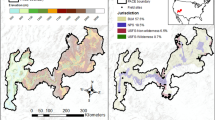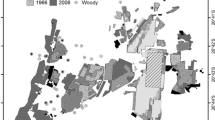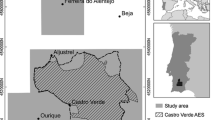Abstract
Context
Native vegetation extent is often a proxy for habitat area in studies of human-modified landscapes. However, the loss and retention of native vegetation is rarely random among landscapes. Instead, the extent of native vegetation in landscapes may be correlated with abiotic factors, thereby obscuring or distorting relationships between ecological phenomena and area.
Objectives
We asked: (1) how has the potential for non-random vegetation loss to confound area effects been addressed in the landscape ecology literature? (2) Are consistent patterns of non-random vegetation loss and retention evident from modified regions of two countries?
Methods
We reviewed 118 papers that related area to an ecological response, to determine whether potential biases associated with non-random vegetation loss and retention were considered. We then analysed ~18,000 100 km2 landscape units in Australia and South Africa to identify how different abiotic factors correlate with the extent of native vegetation retained in those landscapes.
Results
Only 21% of the studies we reviewed explicitly or implicitly considered spatial biases in vegetation clearing. Yet, across modified regions of Australia and South Africa, landscape-scale native vegetation extent was consistently and often strongly related to abiotic factors, particularly soil properties and topographic variability.
Conclusion
Patterns of vegetation clearing and retention commonly reflect underlying abiotic heterogeneity. These biases, which are infrequently highlighted in studies focussing on area effects, have implications for how we assess the importance of vegetation extent for species and assemblages. Failure to account for correlates of vegetation extent risks erroneous area-based conservation prescriptions in human-modified environments.


Similar content being viewed by others
References
Andrén H (1994) Effects of habitat fragmentation on birds and mammals in landscapes with different proportions of suitable habitat: a review. Oikos 71(3):355–366
Baiphethi M, Jacobs P (2009) The contribution of subsistence farming to food security in South Africa. Agrekon 48(4):459–482
Basham R, Law B, Banks P (2011) Microbats in a ‘leafy’ urban landscape: are they persisting, and what factors influence their presence? Austral Ecol 36(6):663–678
Beale CM, Lennon JJ, Yearsley JM, Brewer MJ, Elston DA (2010) Regression analysis of spatial data. Ecol Lett 13(2):246–264
Bennett AF, Watson DM (2011) Declining woodland birds—is our science making a difference? Emu 111(1):i–vi
Beyer HL (2012) Geospatial modelling environment (version 0.7.2.1) (software). http://www.spatialecology.com/gme
Carrara E, Arroyo-Rodriguez V, Vega-Rivera JH, Schondube JE, de Freitas SM, Fahrig L (2015) Impact of landscape composition and configuration on forest specialist and generalist bird species in the fragmented Lacandona rainforest, Mexico. Biol Conserv 184:117–126
Connor EF, McCoy ED (1979) The statistics and biology of the species-area relationship. Am Nat 113(6):791–833
Cowling RM, Pressey RL (2003) Introduction to systematic conservation planning in the Cape Floristic Region. Biol Conserv 112(1):1–13
Crouzeilles R, Prevedello JA, Figueiredo MdSL, Lorini ML, Grelle CEV (2014) The effects of the number, size and isolation of patches along a gradient of native vegetation cover: how can we increment habitat availability? Landscape Ecol 29(3):479–489
Department of the Environment (2012a) Interim biogeographic regionalisation for Australia (IBRA), Version 7 (Regions). Department of the Environment, Canberra. http://www.environment.gov.au/topics/land/national-reserve-system/science-maps-and-data/australias-bioregions-ibra. Accessed 16 Sept 2013
Department of the Environment (2012b) National vegetation information system (NVIS). Department of the Environment, Canberra. http://www.environment.gov.au/land/native-vegetation/national-vegetation-information-system. Accessed 15 Oct 2014
Diniz-Filho JAF, Bini LM, Hawkins BA (2003) Spatial autocorrelation and red herrings in geographical ecology. Glob Ecol Biogeogr 12(1):53–64
Dormann CF, McPherson JM, Araújo MB, Bivand R, Bolliger J, Carl G, Davies RG, Hirzel A, Jetz W, Kissling D, Kühn I, Ohlemüller R, Peres-Neto PR, Reineking B, Schröder B, Schurr FM, Wilson R (2007) Methods to account for spatial autocorrelation in the analysis of species distributional data: a review. Ecography 30(5):609–628
Drinnan IN (2005) The search for fragmentation thresholds in a southern Sydney suburb. Biol Conserv 124(3):339–349
ESRI (2012) ArcMap Version 10.1 (software). Environmental Systems Research Institute, Redlands
Fahrig L (2013) Rethinking patch size and isolation effects: the habitat amount hypothesis. J Biogeogr 40(9):1649–1663
Fischer J, Lindenmayer DB (2007) Landscape modification and habitat fragmentation: a synthesis. Glob Ecol Biogeogr 16(3):265–280
Hadley AS, Frey SJK, Robinson WD, Kress WJ, Betts MG (2014) Tropical forest fragmentation limits pollination of a keystone understory herb. Ecology 95(8):2202–2212
Hanski I (1998) Metapopulation dynamics. Nature 396(6706):41–49
Hanski I (2015) Habitat fragmentation and species richness. J Biogeogr 42:989–993
Harrisson KA, Pavlova A, Amos JN, Takeuchi N, Lill A, Radford JQ, Sunnucks P (2012) Fine-scale effects of habitat loss and fragmentation despite large-scale gene flow for some regionally declining woodland bird species. Landscape Ecol 27(6):813–827
Hawkins BA, Field R, Cornell HV, Currie DJ, Guégan JF, Kaufman DM, Kerr JT, Mittelbach GG, Oberdorff T, O’Brien EM, Porter EE, Turner JRG (2003) Energy, water, and broad-scale geographic patterns of species richness. Ecology 84(12):3105–3117
Hazelton P, Murphy BW (2007) Interpreting soil test results: what do all the numbers mean?. CSIRO Publishing, Melbourne
Hengl T, de Jesus JM, MacMillan RA, Batjes NH, Heuvelink GBM, Ribeiro E, Samuel-Rosa A, Kempen B, Leenaars JGB, Walsh MG, Gonzalez MR (2014) SoilGrids1 km—global soil information based on automated mapping. PLoS ONE 9(8):e105992
Hijmans RJ, Cameron SE, Parra JL, Jones PG, Jarvis A (2005) Very high resolution interpolated climate surfaces for global land areas. Int J Climatol 25(15):1965–1978
ISRIC—World Soil Information (2013) SoilGrids: an automated system for global soil mapping. http://soilgrids1km.isric.org. Accessed 18 June 2014
Januchowski SR, McAlpine CA, Callaghan JG, Griffin CB, Bowen M, Mitchell D, Lunney D (2008) Identifying multiscale habitat factors influencing koala (Phascolarctos cinereus) occurrence and management in Ballarat, Victoria, Australia. Ecol Manag Restor 9(2):134–142
Jarvis A, Reuter HI, Nelson A, Guevara E (2008) Hole-filled SRTM for the globe version 4, available from CGIAR-CSI SRTM 90 m Database. http://srtm.csi.cgiar.org/. Accessed 03 April 2014
Kirsten J, Moldenhauer W (2006) Measurement and analysis of rural household income in a dualistic economy: the case of South Africa. Agrekon 45(1):60–77
Kisel Y, McInnes L, Toomey NH, Orme CDL (2011) How diversification rates and diversity limits combine to create large-scale species-area relationships. Philos Trans R Soc Lond Ser B Biol Sci 366(1577):2514–2525
Lal R (2000) Soil management in the developing countries. Soil Sci 165(1):57–72
Laurance WF (2008) Theory meets reality: how habitat fragmentation research has transcended island biogeographic theory. Biol Conserv 141(7):1731–1744
Laurance WF, Camargo JLC, Luizão RCC, Laurance SG, Pimm SL, Bruna EM, Stouffer PC, Williamson GB, Benítez-Malvido J, Vasconcelos HL, Van Houtan KS, Zartman CE, Boyle SA, Didham RK, Andrade A, Lovejoy TE (2011) The fate of Amazonian forest fragments: a 32-year investigation. Biol Conserv 144(1):56–67
Lima MM, Mariano-Neto E (2014) Extinction thresholds for Sapotaceae due to forest cover in Atlantic Forest landscapes. For Ecol Manag 312:260–270
Lindenmayer D, Bennett AF, Hobbs R (2010) An overview of the ecology, management and conservation of Australia’s temperate woodlands. Ecol Manag Restor 11(3):201–209
Lindenmayer DB, Fischer J (2006) Habitat fragmentation and landscape change: an ecological and conservation synthesis. Island Press, Melbourne
Lindenmayer DB, Luck G (2005) Synthesis: thresholds in conservation and management. Biol Conserv 124(3):351–354
Looney C, Caldwell TB, Eigenbrode DS (2009) When the prairie varies: the importance of site characteristics for strategising insect conservation. Insect Conserv Divers 2(4):243–250
Lunt ID, Spooner PG (2005) Using historical ecology to understand patterns of biodiversity in fragmented agricultural landscapes. J Biogeogr 32(11):1859–1873
Margules CR, Pressey RL (2000) Systematic conservation planning. Nature 405(6782):243–253
Maron M, Bowen M, Fuller RA, Smith GC, Eyre TJ, Mathieson M, Watson JEM, McAlpine CA (2012) Spurious thresholds in the relationship between species richness and vegetation cover. Glob Ecol Biogeogr 21(6):682–692
McGarigal K, Cushman SA (2002) Comparative evaluation of experimental approaches to the study of habitat fragmentation effects. Ecol Appl 12(2):335–345
Morton JF (2007) The impact of climate change on smallholder and subsistence agriculture. Proc Natl Acad Sci USA 104(50):19680–19685
Mucina L, Rutherford MC (eds) (2006) The vegetation of South Africa, Lesotho and Swaziland. South African National Biodiversity Institute, Pretoria
Nufio CR, McClenahan JL, Deane Bowers M (2011) Grasshopper response to reductions in habitat area as mediated by subfamily classification and life history traits. J Insect Conserv 15(3):409–419
Paget MJ, King EA (2008) MODIS land data sets for the Australian region. CSIRO Marine and Atmospheric Research internal report number 004
Peel MC, Finlayson BL, McMahon TA (2007) Updated world map of the Köppen–Geiger climate classification. Hydrol Earth Syst Sci 11:1633–1644
Pinheiro J, Bates D, Debroy S, Sarkar D, The R Development Core Team (2013) nlme: linear and nonlinear mixed effects models. R package version 3.1-109
Polyakov M, Rowles AD, Radford JQ, Bennett AF, Park G, Roberts A, Pannell D (2013) Using habitat extent and composition to predict the occurrence of woodland birds in fragmented landscapes. Landscape Ecol 28(2):329–341
R Core Team (2013) R: a language and environment for statistical computing. R Foundation for Statistical Computing, Vienna
Radford JQ, Bennett AF, Cheers GJ (2005) Landscape-level thresholds of habitat cover for woodland-dependent birds. Biol Conserv 124(3):317–337
Rhodes JR, McAlpine CA, Zuur AF, Smith GC, Ieno EN (2009) GLMM applied on the spatial distribution of koalas in a fragmented landscape. In: Zuur AF, Ieno EN, Walker N, Saveliev AA, Smith GM (eds) Mixed effects models and extensions in ecology with R. Springer, New York
Rompré G, Robinson WD, Desrochers A, Angehr G (2009) Predicting declines in avian species richness under nonrandom patterns of habitat loss in a neotropical landscape. Ecol Appl 19(6):1614–1627
Rosenzweig ML (1995) Species diversity in space and time. Cambridge University Press, Cambridge
Rouget M, Richardson DM, Cowling RM, Lloyd JW, Lombard AT (2003) Current patterns of habitat transformation and future threats to biodiversity in terrestrial ecosystems of the Cape Floristic Region, South Africa. Biol Conserv 112(1):63–85
Seabloom EW, Dobson AP, Stoms DM (2002) Extinction rates under nonrandom patterns of habitat loss. Proc Natl Acad Sci USA 99(17):11229–11234
South African National Biodiversity Institute (2009) National land cover (NLC) 2009 [raster dataset]. South African National Biodiversity Institute, Pretoria. http://bgis.sanbi.org/landcover/project.asp. Accessed 03 April 2014
Stein A, Gerstner K, Kreft H (2014) Environmental heterogeneity as a universal driver of species richness across taxa, biomes and spatial scales. Ecol Lett 17(7):866–880
Storch D, Evans KL, Gaston KJ (2005) The species-area-energy relationship. Ecol Lett 8(5):487–492
Swift TL, Hannon SJ (2010) Critical thresholds associated with habitat loss: a review of the concepts, evidence, and applications. Biol Rev 85(1):35
TERN/AusCover (2013) Normalized Difference Vegetation Index (NDVI) and Enhanced Vegetation Index (EVI)—MODIS, LPDAAC MOD13Q1 mosaic, Australia coverage. Made available by the AusCover facility (http://www.auscover.org.au) of the Terrestrial Ecosystem Research Network (TERN, http://www.tern.org.au). Accessed 17 March 2014
Turner WR, Tjørve E (2005) Scale-dependence in species-area relationships. Ecography 28(6):721–730
Warton DI, Hui FKC (2011) The arcsine is asinine: the analysis of proportions in ecology. Ecology 92(1):3–10
Watson DM (2011) A productivity-based explanation for woodland bird declines: poorer soils yield less food. Emu 111(1):10–18
Watson JEM, Dudley N, Segan DB, Hockings M (2014) The performance and potential of protected areas. Nature 515(7525):67–73
Whittaker RJ, Triantis KA (2012) The species–area relationship: an exploration of that ‘most general, yet protean pattern’. J Biogeogr 39(4):623–626
Zuur AF, Ieno EN, Walker N, Saveliev AA, Smith GM (2009) Mixed effects models and extensions in ecology with R. Springer, New York
Zuur AF, Ieno EN, Elphick CS (2010) A protocol for data exploration to avoid common statistical problems. Methods Ecol Evol 1(1):3–14
Acknowledgements
We thank James Watson for comments on the manuscript, and Talitha Santini for advice on soil properties and relationships. JS was supported by funding from an Australian Government Australian Postgraduate Award scholarship and the Australian Government National Environmental Research Program. MM is supported by ARC Future Fellowship FT140100516.
Author information
Authors and Affiliations
Corresponding author
Electronic supplementary material
Below is the link to the electronic supplementary material.
Rights and permissions
About this article
Cite this article
Simmonds, J.S., van Rensburg, B.J. & Maron, M. Non-random patterns of vegetation clearing and potential biases in studies of habitat area effects. Landscape Ecol 32, 729–743 (2017). https://doi.org/10.1007/s10980-016-0482-7
Received:
Accepted:
Published:
Issue Date:
DOI: https://doi.org/10.1007/s10980-016-0482-7




